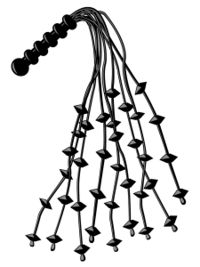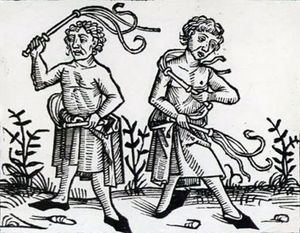Scourging
Scourging is whipping a person with a scourge, a type of multi-lailed whip. Scourging, typically on a person's back, was used in judicial and religious corporal punishment contexts.
Examples
Ancient Greece and Rome
The priests of Cybele scourged themselves and others, and such stripes were considered sacred.
Scourging was the first step in the traditional Ancient Rome punishment for parricide.
In the Bible
In the Old Testament, to be "examined under scourging" (Acts 22:24) referred to an investigation which began with the beating of the prisoner. Another word describes the "whip of cords" with which Jesus cleansed the Temple (John 2:15). Scourging also played a famous role as the punishment inflicted during the Passion of Christ before crucifixion, disabling him from carrying his cross to Golgotha.
In Christian religious contexts
Scourging was soon adopted as a sanction in the monastic discipline of the fifth and following centuries. Early in the fifth century it is mentioned by Palladius of Galatia in the Historia Lausiaca, and Socrates Scholasticus tells us that, instead of being excommunicated, offending young monks were scourged. (See the sixth-century rules of St. Cæsarius of Arles for nuns, and of St. Aurelian of Arles.) Thenceforth scourging is frequently mentioned in monastic rules and councils as a preservative of discipline. Its use as a punishment was general in the seventh century in all monasteries of the severe Columban rule.
Canon law (Decree of Gratian, Decretals of Gregory IX) recognized it as a punishment for ecclesiastics; even as late as the sixteenth and seventeenth centuries, it appears in ecclesiastical legislation as a punishment for blasphemy, concubinage and simony. Though doubtless at an early date a private means of penance and mortification, such use is publicly exemplified in the tenth and eleventh centuries by the lives of St. Dominic Loricatus and St. Peter Damian (died 1072). The latter wrote a special treatise in praise of self-flagellation; though blamed by some contemporaries for excess of zeal, his example and the high esteem in which he was held did much to popularize the voluntary use of the scourge or "discipline" as a means of mortification and penance. Thenceforth it is met with in most medieval religious orders and associations.
The practice was, of course, capable of abuse, and so arose in the thirteenth century the fanatical sect of the Flagellants, though in the same period we meet with the private use of the "discipline" by such saintly persons as King Louis IX of France and Elisabeth of Hungary.
Metaphoric use
Semi-literal usages such as "the scourge of God" for Attila the Hun (i.e. "God's whip to punish the nations with") led to metaphoric uses to mean a severe affliction, e.g. "the scourge of drug abuse". As a result, some people forget its literal meaning and seem to imagine a connection with "scour" -to clean something by scrubbing it vigorously.
Sources, references and notes
- 1911 Encyclopædia Britannica
- Catholic Encyclopaedia
- H. H. Mallinckrodt, Latijn-Nederlands woordenboek (Latin-Dutch dictionary)
- More information is available at [ Wikipedia:Scourging ]
Chat rooms • What links here • Copyright info • Contact information • Category:Root

